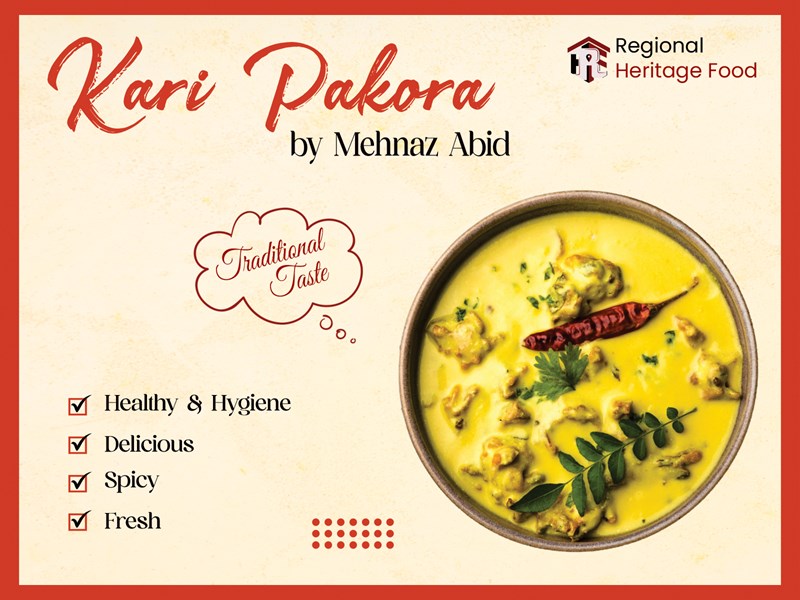Punjabi Kari Pakora Recipe by Mehnaz Abid | Authentic North Indian Comfort Food | RHF (Recipe)

Try Mehnaz Abid's authentic Punjabi Kari Pakora recipe, a traditional North Indian dish featuring a yogurt-based curry with deep-fried gram flour fritters. Perfect for a hearty meal!
Punjabi Kari Pakora Recipe | Kari Pakora by Mehnaz Abid | North Indian Recipes
Introduction
Punjabi Kari Pakora is a beloved North Indian dish that brings together the tangy richness of a yogurt-based curry (Kadhi) and the crispy goodness of deep-fried gram flour fritters (Pakoras). Mehnaz Abid's version of this classic dish offers a perfect balance of spices and textures, making it a must-try recipe for anyone who loves traditional Indian cuisine.
Improved Recipe
Ingredients
For the Kari (Yogurt Curry):
- Yogurt: 1 Kg
- Gram Flour (Besan): 3 tablespoons
- Ghee: 3 teaspoons
- Cumin Seeds: ½ teaspoon
- Ginger-Garlic Paste: 1½ teaspoons
- Red Chili Powder: 1 teaspoon
- Turmeric Powder: ½ teaspoon
- Coriander Powder: 1 teaspoon
- Salt: 1 teaspoon (or to taste)
- Kasuri Methi (Dried Fenugreek Leaves): 1 tablespoon
- Tomato Paste: From 2 tomatoes
- Water: 1 liter
For the Pakoras (Fritters):
- Onion: 2, finely chopped
- Green Chilies: 3, finely chopped
- Green Coriander: Finely chopped
- Red Chili Powder: 1 teaspoon
- Turmeric Powder: ½ teaspoon
- Coriander Powder: 1 teaspoon
- Salt: 1 teaspoon
- Kasuri Methi (Dried Fenugreek Leaves): 1 teaspoon
- Gram Flour (Besan): 200 grams
- Baking Soda: A pinch
- Water: As needed
For the Tadka (Tempering):
- Cooking Oil: 2 tablespoons
- Dried Red Chilies: 2
- Green Chilies: 2, finely chopped (lengthwise)
- Onion: 1 small, finely chopped
- Cumin Seeds: ½ teaspoon
Method
1. Preparing the Kari (Yogurt Curry):
- In a blender, mix 3 tablespoons of gram flour (besan) with a little water until smooth. Add this mixture to 1 kg of yogurt and blend until well combined. Pour in 1 liter of water and mix thoroughly.
- In a saucepan, heat 3 teaspoons of ghee over medium heat. Add 2 bay leaves, ½ teaspoon cumin seeds, and the ginger-garlic paste. Sauté until fragrant.
- Add 1 teaspoon of red chili powder, ½ teaspoon turmeric powder, 1 teaspoon coriander powder, 1 teaspoon salt, and ½ teaspoon Kasuri Methi. Sauté for a few minutes.
- Add the tomato paste and cook until the mixture thickens and the water evaporates.
- Slowly pour in the yogurt-gram flour mixture, stirring constantly to avoid lumps. Bring the mixture to a boil, then reduce the heat to medium-low and simmer for 15-20 minutes, stirring occasionally until the curry thickens.
2. Making the Pakoras (Fritters):
- In a large mixing bowl, combine 200 grams of gram flour, 2 finely chopped onions, 3 finely chopped green chilies, chopped green coriander, 1 teaspoon red chili powder, ½ teaspoon turmeric powder, 1 teaspoon coriander powder, 1 teaspoon salt, and 1 teaspoon Kasuri Methi. Mix well.
- Add a pinch of baking soda and enough water to form a thick batter.
- Heat oil in a frying pan over medium heat. Drop spoonfuls of the batter into the hot oil and fry until the pakoras are golden brown and crispy. Drain on paper towels and set aside.
3. Preparing the Tadka (Tempering):
- In a small frying pan, heat 2 tablespoons of oil. Add 2 bay leaves, 2 dried red chilies, 2 finely chopped green chilies, 1 small finely chopped onion, and ½ teaspoon cumin seeds. Fry for 2-3 minutes until the spices are fragrant and the onions are golden.
4. Final Assembly:
- Add the fried pakoras to the simmering Kari and cook for a few more minutes.
- Pour the prepared tadka over the Kari Pakora.
- Serve hot with naan or steamed rice.
Calories Information
- Calories per serving (approximately 100g): 320-370 kcal
Health Benefits and Precautions
Health Benefits:
- Probiotic-Rich: The yogurt base provides beneficial probiotics that aid in digestion.
- Protein-Packed: Gram flour (besan) is a good source of protein, making the dish nourishing and satisfying.
Precautions:
- Deep-Fried Content: Due to the deep-fried pakoras, it's advisable to enjoy this dish in moderation, especially if you're managing cholesterol levels.
Best Time and Season to Use:
- Best for: A cozy lunch or dinner during cooler weather, offering warmth and comfort with its rich, spiced flavors.